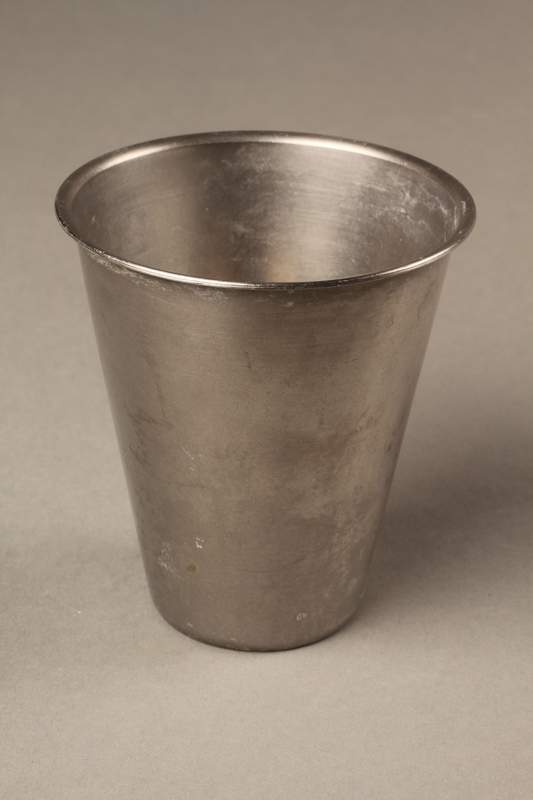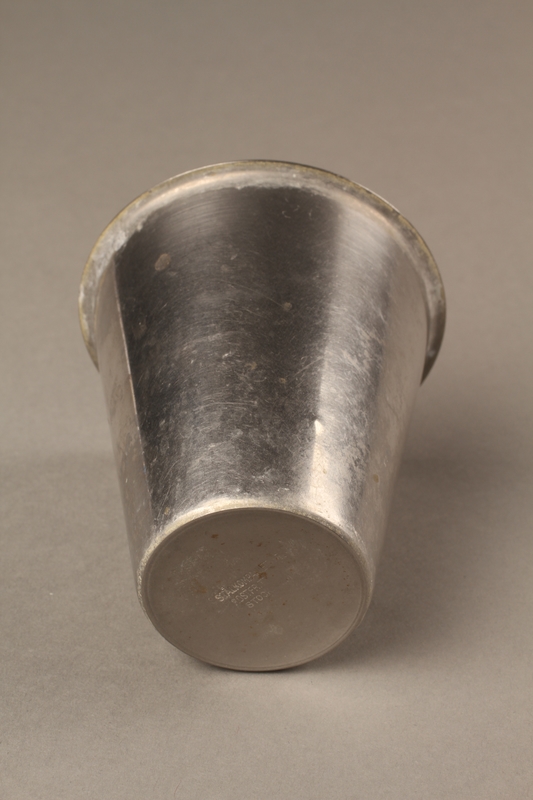Overview
- Brief Narrative
- Stainless steel, toothbrush rinse cup given to Vera Hauser postwar while recovering in a Swedish hospital. Vera was a Hungarian Jewish woman from Budapest. In March 1944, Germany occupied Hungary and in November Vera was rounded up with 70,000 other Jews in Budapest and forced to march to Austria. She survived a mass shooting of her fellow prisoners and was taken by train to Bergen-Belsen concentration camp in Lower Saxony, Germany. While there she contracted typhoid fever. Bergen-Belsen was liberated by the British army on April 15, 1945. Vera was sent to a hospital in Sigtuna, Sweden to recover from her illness. While there she befriended a nurse and lived with her family. Before she left Sweden in 1946, Vera’s friend gave her several objects to take home with her. When Vera returned to Hungary, she found her family destitute. To help provide for her family, she sold all the possessions she was given in Sweden except for the toothbrush rinse cup.
- Date
-
received:
1945-1946
- Geography
-
received:
Sweden
manufacture: Stockholm (Sweden)
- Credit Line
- United States Holocaust Memorial Museum Collection, Gift of Vera Hauser
- Markings
- exterior bottom, center, engraved : STÄLKOMPANIET AB / ROSTFRITT / STOCKHOLM [Steel company AB / stainless / Stockholm]
- Contributor
-
Subject:
Vera Weil Hauser
- Biography
-
Vera Hauser (Vera Weil) was born in Budapest, Hungary in 1927 to Elias and Regina Hirsch. The family lived in the Pestszenterzséb suburb of the city. In 1936, 3,978 Jews lived in Pestszenterzséb. The suburb had a Jewish school and most of the Jewish residents worked as laborers. In November of 1940, Hungary joined the Axis Powers, allying with Germany and Italy. Between 1938 and 1941, Hungary passed a number of racial laws based on Nazi Germany’s Nuremberg Laws. They barred Jews from many professions, took away equal citizenship for Jewish people, and forbid marriage between Jews and non-Jews. In 1941, the Hungarian authorities began deporting Jews from the annexed territories of Czechoslovakia, Romania, and Yugoslavia. In 1942, the German government began to pressure Hungary to deport their native Jewish population. The Hungarian government refused.
On March 19, 1944, Hungary initiated talks for an armistice with the Allies. In response, Germany occupied Hungary and installed a pro-German government. In May 1944, the authorities began deporting Hungarian Jews to concentration camps in Germany. On November 8, 1944, Vera was rounded up along with 70,000 other Jews in Budapest and forced to march to Austria. She survived a mass shooting of her fellow prisoners and was taken by train to Bergen-Belsen concentration camp in Lower Saxony, Germany. Vera was a prisoner in Bergen-Belsen from November 1944 until the camp was liberated by the British on April 15, 1945. At liberation, Vera was so weak and sick with typhoid fever she was unable to walk.
After the war, through an arrangement with the United Nations Relief and Rehabilitation Administration (UNRRA), Sweden agreed to receive approximately 11,000 concentration camp prisoners and provide care for them while they recovered. Vera, along with 1,200 other survivors were transported to a hospital in Sigtuna, Sweden to recover. Initially, Vera stayed with the other survivor patients in a school modified to accommodate them. She became friends with one of the nurses and lived with her family for the following year. In 1946, Vera wanted to return to Hungary to find her family. Before she left, her host family gave her several gifts. When she returned home to Hungary, she found her family still living, but destitute. Vera sold all but one of the items she received in Sigtuna to provide for her family.
Physical Details
- Classification
-
Household Utensils
- Category
-
Drinking vessels
- Object Type
-
Drinking cups (lcsh)
- Genre/Form
- Cup.
- Physical Description
- Stainless steel, plain silver colored, conical toothbrush cup with a slightly concave, narrow base that widens towards the flared rimmed opening. The interior has a dark patina and is slightly tarnished and corroded on the sides and bottom. The exterior has some tarnish from use. There are three lines of Swedish text engraved on the bottom.
- Dimensions
- overall: Height: 3.375 inches (8.573 cm) | Width: 3.250 inches (8.255 cm) | Depth: 3.250 inches (8.255 cm)
- Materials
- overall : metal
Rights & Restrictions
- Conditions on Access
- No restrictions on access
Keywords & Subjects
- Topical Term
- Hygiene. World War, 1939-1945--Jews--Hungary. Women concentration camp inmates--Germany--Biography. Holocaust, Jewish (1939-1945)--Europe--Hungary. World War, 1939-1945--Jews--Rescue--Sweden. Humanitarian assistance--Sweden--History--20th century. Jews--Sweden--History--20th century.
- Geographic Name
- Stockholm (Sweden). Sigtuna (Sweden). Lower Saxony (Germany). Hungary.
- Corporate Name
- Bergen-Belsen (Concentration camp)
Administrative Notes
- Legal Status
- Permanent Collection
- Provenance
- The cup was donated the United States Holocaust Memorial Museum in 2016 by Vera Hauser.
- Record last modified:
- 2024-03-29 11:52:52
- This page:
- https://collections.ushmm.org/search/catalog/irn551453
Also in Vera Hauser collection
The collection consists of a toothbrush cup, newspaper clippings, documents, and photographs relating to the experiences of Vera Hauser in Sweden after World War II.
Date: 1945-1946
Vera Hauser papers
Document
Documents including: "Lakarkort", in Swedish; 2 "Field Medical Cards"; Identity card issued by the Hungarian Consulate in Sweden in 1946; letter regarding repatriation; Newspaper clippings; family photographs





